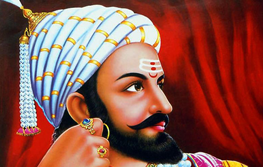Shivaji Bhosle was an Indian warrior king and a member of the Bhonsle Maratha clan. Shivaji carved out an enclave from the declining Adilshahi sultanate of Bijapur that formed the genesis of the Maratha Empire. In 1674, he was formally crowned as the chhatrapati (monarch) of his realm at Raigad
Shivaji was born in the hill-fort of Shivneri, near the city of Junnar in what is now Pune district on 6 April 1627 or 19 February 1630. Shivaji was named after a local deity, the goddess Shivai.[1] Shivaji’s father Shahaji Bhosale was a Maratha general who served the Deccan Sultanates.[7] His mother was Jijabai, the daughter of Lakhuji Jadhavrao of Sindhkhed, a Mughal-aligned sardar claiming descent from a Yadav royal family of Devagiri.
At the time of Shivaji’s birth, power in Deccan was shared by three Islamic sultanates: Bijapur, Ahmednagar, and Golkonda.
Shahaji often changed his loyalty between the Nizamshahi of Ahmadnagar, the Adilshah of Bijapur and the Mughals, but always kept his jagir (fiefdom) at Pune and his small army with him.
Shivaji was devoted to his mother Jijabai, who was deeply religious. This religious environment had a great impact on Shivaji, and he studied the two great Hindu epics, Ramayana and Mahabharata; these were to influence his lifelong defence of Hindu values. Throughout his life he was deeply interested in religious teachings, and regularly sought the company of Hindu and Sufi saints. Shahaji, meanwhile had married a second wife, Tuka Bai from the Mohitefamily. Having made peace with the Mughals, ceding them six forts, he went to serve the Sultanate of Bijapur. He moved Shivaji and Jijabai from Shivneri to Pune and left them in the care of his jagir (estate) administrator, Dadoji Konddeo. Dadoji has been credited with overseeing the education and training of young Shivaji.
Shivaji as a boy was a keen outdoorsman and, though he received little formal education and most likely could neither read nor write, he is said to have possessed considerable erudition.
Shivaji drew his earliest trusted comrades and later a large number of his soldiers from the Maval region, including Yesaji Kank, Suryaji Kakade, Baji Pasalkar, Baji Prabhu Deshpande and Tanaji Malusare. Shivaji wandered the hills and forests of the Sahyadri range with his Mavala friends, gaining skills and familiarity with the land that would prove useful in his military career.
Conflict with Bijapur
– Combat with Afzal Khan
– Siege of Panhala
– Battle of Pavan Khind
Conflict with the Mughals
– Attacks on Shaista Khan and Surat
– Treaty of Purandar
– Arrest in Agra and escape
– Peace with the Mughals
Reconquest
– Battles of Umrani and Nesari
In late March 1680, Shivaji fell ill with fever and dysentery, dying around 3–5 April 1680 at the age of 52,on the eve of Hanuman Jayanti.

